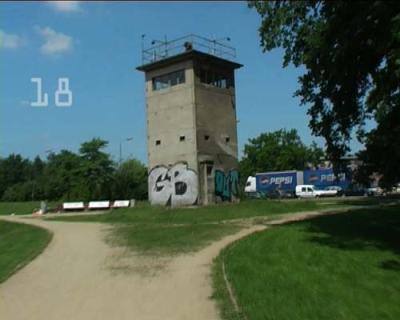Kunstkaart

Camilio van Lenteren / In BetweeN (minute 18)
In Between.
Filming a route which is heavy emotionally / historically loaded, show the reality how it is now, totally, no cuts, no false shots, no fake camera work. In this Time, in my life.
History, a historically determined route through Berlin. A city where the cold war had its face. Divided into two parts as a result of the Second World War. An insane structure meant to separate two different ideologies. Thrown away, abused pushed away into memory after the tear down on November 9th 1989. Almost 14 years later you can still see the consequences of the wall. People speak of Ossies and Wessies, there are still too many civil servants in service, two zoos, two academies, two (or even more) town centres and even within the city’s image (architecture, infrastructure) it is noticeable. I wondered what is left of a structure that was once so powerful and now seems to be forgotten. When we spoke/speak of the wall we usually looked/look upon it from a Western view. But in fact it is the last barrier of an entire barrier system. A structure of two walls with a dead zone in between. It is that dead zone that I wanted to document, because it was the necessary minimal space that was needed tot separate two huge aggressors. A zone that was at least a street, but sometimes but 100 meters wide.
Three days of research about the location of the wall within the city of Berlin (about 44 kilometres) showed, to my surprise, that the major part of the dead (wall) zone is still there. Here, one can also occasionally find pieces of the wall, three authentic intake towers and other traces. After this research my desire to document the whole section only grew. I mounted a tripod and camera onto my mountain-bike and taped the wall onto my mini DV (video), again in three days. The camera was placed at eye level (height), but because the film is replayed accelerated, the result is almost perceived as a bird's-eye view. The video is edited so that it seems as if the film was shot in one day (same weather, elapse of time, etc.). Consequently, the film is accelerated so that 5½ hours become 29 minutes. Due to the acceleration the film has become even shakier and the sound (original recording, according to the dogma principle) seems to have become almost music, which enlarges its importance. Because time is an important factor, the proceeding minutes are visible. Time is important, because the wall was there for almost 30 years. That is the story that is always told. In fact it was 28 years (form August 30th 1961 to November 8th 1989), which made me add a subtitle to the movie: almost 30 years, almost 30 minutes. In Between is the main title, because during the biking I constantly found myself in the one place where there were no walls, where only animals had free access, where there was no city anymore, and because I wanted to emphasise that the wall was not only the Western wall, but a system of walls, completely situated at Eastern territory. I’m emphasising this, because history is constantly looked at from a dominant Western point of view, the materialistic, capitalistic point of view. Eastern Berlin became Berlin again and the capital of reunited Germany, and that is that? One can still find the Western wall on maps and signposts, the rest is being ignored. Just like the Ossies, their history, their lives for those almost 30 years during that regime. Only now, almost 14 years later, recognition is emerging. Books are being published, the film Goodbye Lenin has been released (very recently in The Netherlands as well) and the voices of the people themselves become more powerful.
The film is finished now and has been presented. Most people find it impressive, mostly because of the historical background. I now want to search for more of these kind of routes and capture them in documentary-like movies. I also want to keep tracking the history of the wall and that of the wall that is being pulled up in Israel (with the rest of the world passively watching) and between Mexico and America. I am also working on the impact of this movie itself. Watching it without any background knowledge, it is still very interesting. People keep looking, wondering where the route leads. Does something familiar show up, does the biker get involved in an accident or does something else happen? Does the camera change from shaky to fluently flying? Etcetera. This film has been a good step in my development and there is still enough to harvest and develop from it.
